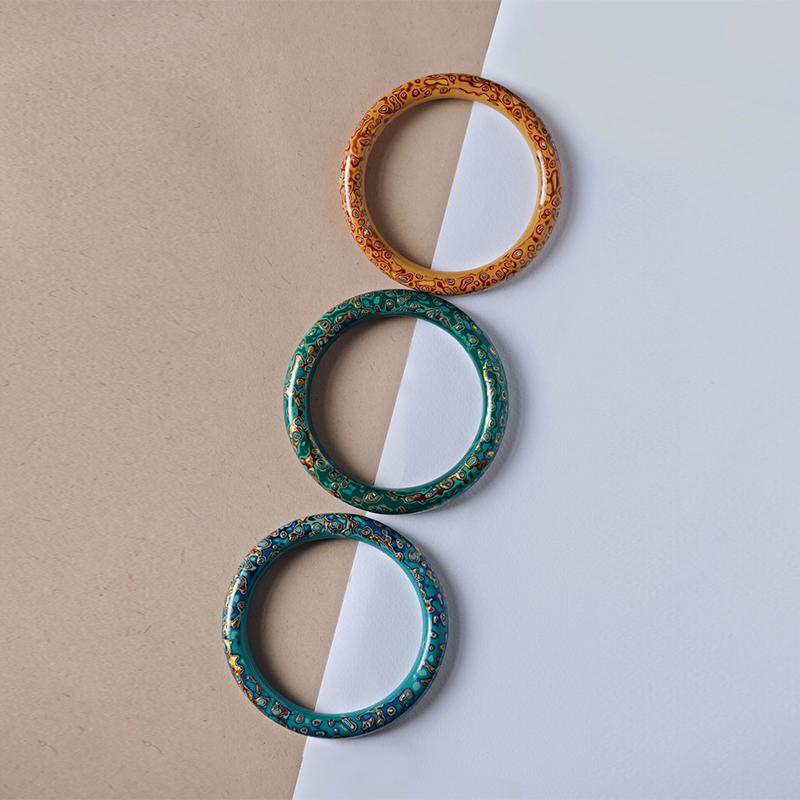1. Traditional Asian Bracelet Materials
China: Jade and Silver Mastery
Northern Chinese artisans craft 925 sterling silver bracelets using repoussé techniques, with intricate dragon motifs requiring 8,000–10,000 hammer strikes. Southern regions specialize in nephrite jade bracelets carved from Hetian seed material (density: 2.95 g/cm³), employing hollow-carving methods to improve material efficiency by 40%. Fujian lacquer bracelets layer hemp cloth and raw urushi resin in humidity-controlled chambers for 90 days, producing lightweight yet durable designs.
India: Sacred Metalwork
Tamil Nadu’s Thanjavur gold bracelets (22K purity) use lost-wax casting to achieve 0.2 mm precision in deity reliefs. Rajasthani Meenakari enamel artisans blend eight mineral pigments (including lapis lazuli and malachite) fired at 750°C. Modern hybrids combine gold with sandalwood (BHN hardness: 1,360), balancing metallic brilliance with organic warmth.
2. Unique African Bracelet Materials
West Africa: Tribal Metallurgy
Nigeria’s Yoruba people cast bronze “Ife” bracelets (8% tin) using 12-phase lunar cycle patterns. Mali’s Dogon tribe forges meteoritic iron bracelets (5% nickel) displaying Widmanstätten patterns through 15,000 hammer strikes. Ghanaian designers repurpose aluminum cans (0.15 mm thickness) into ripple-textured bracelets, producing 5,000 units monthly.
North Africa: Ancient Techniques
Egyptian faience bracelets, made from quartz and alkali glaze since the Pharaonic era, still require 800°C kiln firing for vitrification. Tunisian silversmiths electroform 925 silver around gypsum crystals (Mohs 2), creating “Desert Rose” designs that encapsulate fragile minerals.
3. Evolution of European Bracelet Craftsmanship
Mediterranean Traditions
Murano glassmakers fuse 24K gold leaf into molten glass at 1,200°C, achieving 0.5‰ gold content. Greek artisans on Corfu weave triple-strand silver wires (0.3 mm diameter) into Phoenician-inspired patterns.
Nordic Innovation
Norway’s Sámi people craft reindeer leather bracelets (1.2 mm thickness) tanned with birch bark, paired with nickel-free fittings for Arctic durability. Icelandic studios melt basalt (1,250°C melting point) using geothermal energy to create volcanic glass bracelets.
4. Indigenous American Bracelet Characteristics
North American Tribes
Navajo silversmiths use Colorado Plateau sandstone molds for “sand-cast” silver bracelets that capture regional geology. Pacific Northwest artisans angle-cut abalone shell (refractive index: 1.53–1.56) to create iridescent totem designs.
South American Heritage
Amazonian Yanomami craft buoyant bracelets from “wood of tears” (density: 0.3 g/cm³), waterproofed with macaw feathers. Andean metalsmiths develop “moonlight alloy” (82% silver, 18% platinum) that fluoresces under high-altitude UV exposure.
5. Oceanic Materials in Pacific Bracelets
Polynesian Islands
Samoan whale-tooth bracelets (density: 1.95 g/cm³) are polished with shark skin to create concentric growth rings. Tongan royalty wear mother-of-pearl bracelets from black-lipped oysters exceeding 30 mm diameter, precision-cut with waterjet technology.
Australian Indigenous Art
Kimberley artists use iron-rich ochre (62% Fe content) bound with natural adhesives to create seasonal color bracelets. Tasmanian designers encapsulate deep-sea sponge spicules (0.1–2 mm length) in resin for bioluminescent night bracelets.
6. Modern Hybrid Material Trends
Technological Advancements
German-engineered Ti-6Al-4V titanium bracelets bend 220° via body heat activation. Japanese lab-grown coral bracelets (6-month cultivation) achieve 30% greater hardness than natural counterparts.
Sustainable Solutions
Dutch designers compound marine plastics (PP/PE blend) with basalt fiber for 480 MPa tensile strength bracelets. London studios cultivate mycelium-based biodegradable bracelets with 10-day growth cycles, featuring unique organic textures.
7. Appendix: Global Material Comparison Table
| Material | Density (g/cm³) | Mohs Hardness | Corrosion Resistance | Cultural Region |
|---|---|---|---|---|
| Burmese Jadeite | 3.30–3.36 | 6.5–7 | ★★★★☆ | East Asia |
| 925 Sterling Silver | 10.4 | 2.7 | ★★★☆☆ | Global |
| Meteoritic Iron | 7.9 | 4.5 | ★★★★☆ | West Africa |
| Abalone Shell | 2.85 | 2.5 | ★★☆☆☆ | North America |
| Memory Titanium | 4.5 | 6 | ★★★★★ | Contemporary Design |


Leave a Reply